Chinese Journal of Tissue Engineering Research ›› 2025, Vol. 29 ›› Issue (17): 3675-3683.doi: 10.12307/2025.630
Previous Articles Next Articles
Role of ferroptosis in ischemic brain injury and the regulatory mechanism of traditional Chinese medicine
Zhou Panpan1, Yang Tong2, Wang Shurui2, Cui Yinglin2
- 1The Second Clinical Medical College of Henan University of Chinese Medicine, Zhengzhou 450002, Henan Province, China; 2Henan Provincial Hospital of Traditional Chinese Medicine, Zhengzhou 450002, Henan Province, China
-
Received:2024-05-22Accepted:2024-07-20Online:2025-06-18Published:2024-11-06 -
Contact:Cui Yinglin, MS, Chief physician, Doctoral supervisor, Henan Provincial Hospital of Traditional Chinese Medicine, Zhengzhou 450002, Henan Province, China -
About author:Zhou Panpan, MD candidate, The Second Clinical Medical College of Henan University of Chinese Medicine, Zhengzhou 450002, Henan Province, China -
Supported by:Henan Province Chinese Medicine Scientific Research Special Project, No. 2023ZY1007 (to CYL); Research on the Development Status and Countermeasures of Chinese Medicine Health Tourism in Henan Province under the Perspective of Embodiment, No. TCM2022018 (to YT); The Second National Famous Chinese Medicine Doctor Inheritance Workshop Construction Project of the State Administration of Traditional Chinese Medicin in 2022, No. [2022]245 (to CYL)
CLC Number:
Cite this article
Zhou Panpan, Yang Tong, Wang Shurui, Cui Yinglin . Role of ferroptosis in ischemic brain injury and the regulatory mechanism of traditional Chinese medicine[J]. Chinese Journal of Tissue Engineering Research, 2025, 29(17): 3675-3683.
share this article
Add to citation manager EndNote|Reference Manager|ProCite|BibTeX|RefWorks
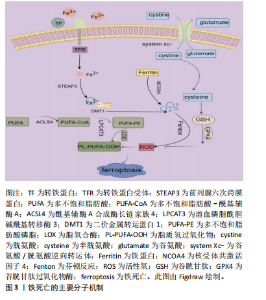
2.1 铁死亡概述 铁死亡是一种铁依赖性脂质过氧化调控的程序性细胞死亡方式,是在Fe2+和活性氧的作用下,细胞膜中的不饱和脂肪酸磷脂不断发生脂质过氧化级联反应,损伤细胞的结构和功能,最终导致细胞死亡。其主要特征为铁超载、活性氧募集、谷胱甘肽减少、谷胱甘肽过氧化物酶(glutathione peroxidase 4,GPX4)失活、线粒体膜密度增加、线粒体嵴减少[9-10]。 铁超载是铁死亡发生、发展的关键。正常情况下,机体内Fe3+与转铁蛋白形成复合物,之后与细胞膜上转铁蛋白受体结合进入细胞内,形成Fe2+,经二价金属转运蛋白1(DMT1)介导,储存在不稳定的铁池或铁蛋白中;此外,细胞内Fe2+可经铁泵蛋白氧化形成Fe3+转运出细胞,以维持细胞内铁稳态[11]。脑缺血后,铁代谢失调,细胞外铁浓度升高,转铁蛋白受体对Fe3+的摄取增多,导致细胞内Fe2+增多[12]。同时,Tau蛋白介导的APP转运和铁转运蛋白1(ferroportin,FPN1)活性降低,抑制铁输出,过量的Fe2+在细胞内发生芬顿反应,产生大量活性氧,与细胞膜上的多不饱和脂肪酸发生氧化反应,损伤细胞,诱发铁死亡[13-14]。研究发现,含有多不饱和脂肪酸的磷脂为铁死亡发生的底物,酰基辅酶A合成酶长链家族4 (acyl-CoA synthetase long-chain family 4,ACSL4)能催化多不饱和脂肪酸乙酰化产生多不饱和脂肪酸-酰基辅酶A,经溶血磷脂酰胆碱酰基转移酶3酯化,与磷脂酰乙醇胺反应生成多不饱和脂肪酸磷脂,之后在质膜和内质网上经脂氧合酶介导发生酶促反应,产生脂质氢过氧化物(PL-PUFA-OOH),从而导致铁死亡[15-16]。此外,当抑制或敲除ACSL4基因时,可降低多不饱和脂肪酸磷脂的生成,从而抑制铁死亡的发生。 谷胱甘肽、GPX4是铁死亡脂质过氧化关键的调节因子。谷胱甘肽由谷氨酸、甘氨酸、半胱氨酸合成,其中由胱氨酸还原的半胱氨酸是谷胱甘肽合成的重要限速底物[17],溶质载体家族7成员11(solute carrier family 7,membrane 11,SLC7A11)是谷氨酸/胱氨酸逆向转运体(glutamate/cystine cystine antiporter,system Xc-)的主要亚基,通过促进胱氨酸向细胞内转入,从而促进谷胱甘肽的合成[18]。GPX4是一种抗氧化酶,在谷胱甘肽的作用下可将脂质过氧化物(L-OOH)转化为脂醇(L-OH),减少活性氧产生,抑制脂质过氧化,从而减轻氧化损伤[19-20]。铁死亡主要分子机制见图3。 2.2 铁死亡相关信号通路 2.2.1 谷胱甘肽/GPX4信号通路 谷胱甘肽/GPX4是细胞内重要的抗氧化通路,主要由谷胱甘肽、GPX4、system Xc-、半胱氨酸、谷氨酸组成[21]。GPX4在还原型谷胱甘肽的作用下,可清除自由基,保护细胞,当谷胱甘肽缺乏时会导致GPX4活性降低,引起铁死亡。System Xc-是一种氨基酸反转运蛋白,下调System Xc-表达,可导致细胞内胱氨酸水平下降,进而导致谷胱甘肽耗竭,诱发氧化损伤及铁死亡[22]。 2.2.2 核因子E2相关因子2/血红素加氧酶1信号通路 核因子E2相关因子2(Nrf2)是一种重要的抗氧化调节因子,"
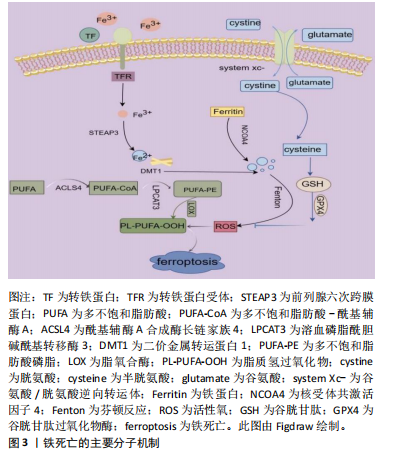
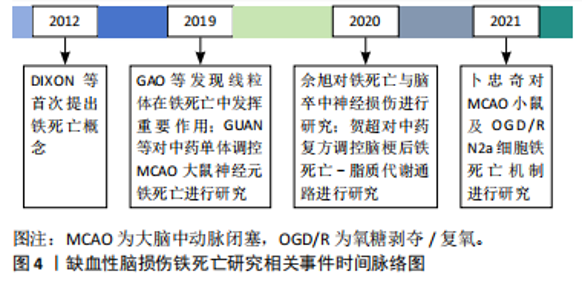
血红素加氧酶1(HO-1)是核因子E2相关因子2的下游信号分子[23]。氧化应激时,过量的活性氧诱导核因子E2相关因子2表达,激活下游血红素加氧酶1表达,进而促进谷胱甘肽、GPX4表达,发挥抗氧化作用[24]。此外,核因子E2相关因子2可增加铁蛋白重链1和铁转运蛋白1的表达,以排出或储存Fe2+,减少细胞内铁含量,抑制铁死亡。 2.2.3 FSP1/CoQ10信号通路 铁死亡抑制蛋白1(Ferroptosis suppressor protein 1,FSP1)是一种烟酰胺腺嘌呤二核苷酸磷酸(NADPH)依赖性泛醌氧化还原酶,通过豆蔻酰化修饰定位于质膜,从而将CoQ10还原为二氢泛醌(Co QH2),以清除细胞内活性氧和自由基,抑制铁死亡[25]。CoQ10是铁死亡抑制蛋白1的主要底物,抑制CoQ10的生成,可降低铁死亡抑制蛋白1抗氧化功能,加速细胞铁死亡[26]。 2.2.4 GCH1/BH4信号通路 鸟苷三磷酸环水解酶1(GTP cyclohydrolase1,GCH1)/四氢生物喋呤(tetrahydrobiopterin,BH4)是一条不依赖于GPX4的独立抗氧化通路[27]。GCH1是BH4合成的第一限速酶,通过增加还原型CoQ10的表达,并降低PUFA-PLs的水平,以减少细胞对铁死亡的敏感性。BH4是内源性抗氧剂,可清除自由基,抑制活性氧生成,发挥抗氧化作用。 此外,抑制细胞铁死亡的信号通路还包括溶质载体家族7成员11(SLC7A11)/谷胱甘肽过氧化物酶4(GPX4)信号通路[28]、腺苷酸活化蛋白激酶(AMPK)信号通路[29]、丝裂原活化蛋白激酶(MAPK)信号通路等[30]。 2.3 铁死亡与缺血性脑损伤 缺血性脑损伤铁死亡研究相关事件时间脉络图,见图4。"
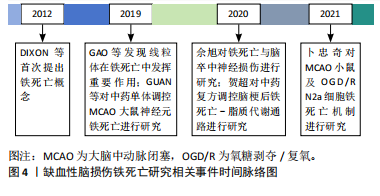
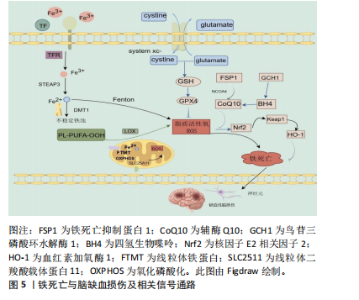
脑缺血发生时,小胶质细胞受到缺血刺激过度激活,导致血脑屏障破坏,促使细胞内Fe2+增多,排出减少,导致铁代谢失调,诱发铁死亡[31-32]。研究发现,在小鼠大脑中动脉闭塞模型中,术后72 h检测到缺血损伤区域铁沉积[33],在大脑中动脉闭塞大鼠模型中,铁摄入量与脑梗死面积成正比,给予铁螯合剂可减少铁积累,减小梗死面积[34]。此外,大量研究结果表明缺血性脑卒中患者血清中铁、铁蛋白水平显著升高,且与神经功能损伤程度呈正相关,而及时降低血清中铁蛋白水平,可减少患者神经功能缺损及病死率[35-36]。以上研究结果均证实铁超载与缺血性脑卒中密切相关,是脑损伤的重要病理因素之一。 脑缺血后产生大量的活性氧,而脑损伤与活性氧激活铁死亡密切相关。脑缺血后活性氧产生机制如下:①缺血时细胞内三磷酸腺苷(ATP)耗竭,无氧糖酵解过程中产生大量次黄嘌呤,再灌注后次黄嘌呤在黄嘌呤氧化酶的作用下产生大量活性氧[37];②脑缺血后线粒体结构和功能损伤,氧化磷酸化过程中电子传递链(ETC)效能降低,自由基生成增多,再灌注时产生大量活性氧[38];③脑缺血缺氧时细胞膜功能受损,Ca2+内流增加,导致细胞内Ca2+超载,进而激活磷脂酶A2,在环加氧酶和脂加氧酶作用下水解胞膜磷脂,形成花生四烯酸的过程中产生大量羟基自由基和过氧化氢[39];④脑缺血时小胶质细胞和星形胶质细胞被激活,释放各种促炎因子、趋化因子及黏附分子,吸引大量中性粒细胞聚集并激活,再灌注后,激活的中性粒细胞耗氧量显著增加,产生大量氧自由基[40]; ⑤缺血刺激时,交感-肾上腺髓质系统被激活,释放大量儿茶酚胺,儿茶酚胺自身氧化,可产生大量活性氧[41]。见图5。 2.4 中药对铁死亡的调控作用 2.4.1 中药复方对铁死亡的调控作用 (1)补阳还五汤:补阳还五汤出自《医林改错》,由黄芪、当归、川芎、地龙、赤芍、桃仁及红花组成,具有益气活血、祛瘀通络之功[42]。蔡国英等[43]观察补阳还五汤对大脑中动脉闭塞模型大鼠的神经保护机制,发现其可降低大鼠脑组织Fe2+及血清丙二醛水平,增加谷胱甘肽水平,上调GPX4蛋白表达,提示补阳还五汤通过增强GPX4表达抑制铁死亡、减轻再灌注损伤。此外,梁祺等[44]通过体外实验研究发现,补阳还五汤可提高氧糖剥夺模型PC12细胞活力及超氧化物歧化酶活性,降低活性氧及丙二醛水平,抑制转铁蛋白受体及铁调素表达,上调膜铁转运蛋白表达,从而抑制铁死亡,减轻神经元损伤。"
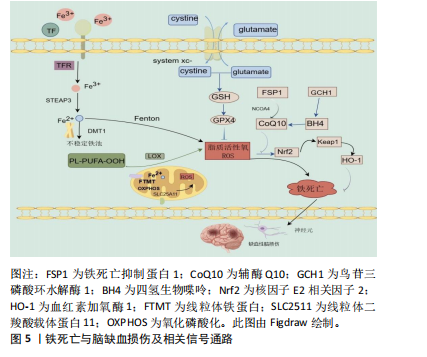
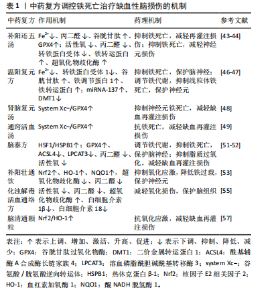
(2)温阳复元方:温阳复元方以“白附片、黄芪、党参、石菖蒲、淫羊藿、田三七”药物为组成,具有温阳益气、化痰通络之功,治疗缺血性脑卒中元阳亏虚证,临床效果显著[45]。向军军等[46]就温阳复元方对缺血再灌注损伤大鼠神经功能影响的研究发现,该方可降低大鼠神经功能评分、改善病理损伤,降低Fe2+含量及转铁蛋白受体1表达,增加谷胱甘肽、IRP1含量,上调铁转运蛋白表达,从而改善铁代谢、抑制铁死亡、保护脑神经。此外,邓秋媚等[47]亦证实,温阳复元方可通过激活miRNA-137/线粒体铁死亡通路,上调miRNA-137及铁转运蛋白表达,下调二价金属转运蛋白1蛋白表达,调节铁代谢,抑制线粒体铁死亡,保护神经元。 (3)肾脑复元汤:肾脑复元汤以经典方补阳还五汤为基础化裁而来,组方药物为熟地黄、黄芪、当归、川芎、牡丹皮、赤芍、红景天、地龙、山药、丹参、山茱萸,具有填精生髓、益气活血之功[48]。杨莹婕[48]研究发现,肾脑复元汤可降低大脑中动脉闭塞模型大鼠神经功能评分,减轻神经元病理损伤,降低脑组织中铁聚集,上调SLC7A11、GPX4表达,提示肾脑复元汤通过激活System Xc-/GPX4通路,抑制神经元铁死亡,减轻大鼠脑缺血再灌注损伤。 (4)通窍活血汤:通窍活血汤源自《医林改错》,组成包括麝香、川芎、赤芍、桃仁、红花、生姜、大枣、老葱、黄酒,具有醒脑开窍,活血祛瘀之效[49]。娄原[49]就不同剂量通窍活血汤(THD)干预脑缺血再灌注损伤大鼠研究发现,高剂量通窍活血汤7.95 g/(kg·d)连续灌胃7 d,可显著降低大鼠神经功能评分,减小脑梗死面积,降低脑组织中丙二醛、Fe2+水平,增加谷胱甘肽水平,上调GPX4、SLC7A11表达,提示通窍活血汤通过调控System Xc-/GPX4通路,抗铁死亡,减轻脑缺血再灌注损伤。 (5)脑泰方:葛金文教授团队研发的脑泰方(黄芪、川芎、僵蚕、地龙),具有补气活血、化瘀通络之功,用于缺血性脑卒中急性期,临床效果显著[50]。饶政清等[51]研究发现,予大脑中动脉闭塞模型大鼠脑泰方27 g/kg灌胃,1次/d,持续7 d,可缩小梗死面积、减少神经功能评分及神经元内铁聚集,降低脑铁、丙二醛及活性氧含量,促进脑内HSF1、HSPB1及铁蛋白重链1表达,抑制转铁蛋白受体1表达,提示脑泰方通过上调HSF1/HSPB1通路,调节铁代谢,抑制铁死亡,保护脑神经。此外,有文献报道脑泰方可上调大脑中动脉闭塞模型大鼠脑组织中GPX4表达,下调ACSL4、溶血磷脂酰胆碱酰基转移酶3表达,降低丙二醛及活性氧水平,从而抑制脂质过氧化,改善大鼠脑缺血再灌注神经损伤[52]。 (6)补阳壮通饮:补阳壮通饮组方包括扶芳藤、黄芪、黄花倒水莲、参三七、地龙、大血藤、走马胎、大叶千斤拔、水菖蒲9味中药,功效为补气活血、祛瘀通络[53]。王亚南[53]就补阳壮通饮对大脑中动脉闭塞/再灌注大鼠神经功能影响的研究发现,该方可改善大鼠神经缺损症状,减小脑梗死面积,减轻脑组织病理损伤,上调核因子E2相关因子2、血红素加氧酶1、NQO1的表达,降低超氧化物歧化酶活力,减少丙二醛含量,提示其通过激活核因子E2相关因子2信号通路,抑制氧化应激,降低铁过载,保护神经元。 (7)化浊解毒活血通络方:田军彪教授自拟化浊解毒活血通络方(石菖蒲、茯苓、泽泻、川芎、丹参、赤芍、地龙、当归、黄连、郁金),具有化浊解毒、益气通络之功[54]。曹晓慧等[55]研究发现,化浊解毒活血通络方可降低大脑中动脉闭塞模型大鼠脑活性氧含量和血清丙二醛含量,增加超氧化物歧化酶活性,减少炎症因子白细胞介素1β、白细胞介素18表达,减轻氧化损伤,保护脑组织。 (8)脑清通颗粒:脑清通颗粒由张学文教授所创,方中药物为决明子、菊花、川芎、丹参、赤芍、水蛭、姜半夏、山楂、神曲、豨莶草、石菖蒲,具有清肝化瘀,化痰通络之效,临床用于缺血性脑卒中肝热痰瘀证,疗效确切[56]。严亚锋等[57]研究发现,脑清通颗粒可显著降低大脑中动脉闭塞模型大鼠神经缺损及梗死面积,升高血清超氧化物歧化酶活性,降低丙二醛水平,下调脑组织Keap1表达,上调核因子E2相关因子2、血红素加氧酶1表达,提示脑清通颗粒通过激活核因子E2相关因子2/血红素加氧酶1通道,抗氧化应激,减轻脑缺血再灌注损伤。 由上可知,中药复方补阳还五汤、温阳复元方、肾脑复元汤及脑清通颗粒等均可通过调控铁死亡相关信号通路及蛋白表达,抑制铁聚集、减少活性氧产生、抗氧化应激等,抑制神经元铁死亡,减轻脑缺血再灌注损伤,发挥脑保护作用。具体机制见表1。 2.4.2 中药有效成分对铁死亡的调控作用 (1)萜类 地黄苷A(Rehmannioside A,ReA):是从地黄中提取的一种生物活性成分,具有抗氧化、抗炎、抗凋亡等作用[58]。Fu等[59]发现,地黄苷A (80 mg/kg)腹腔内注射可缩小大脑中动脉闭塞模型大鼠的脑梗死面积,改善认知功能,此外,地黄苷A (80 μmol/L)预处理经过氧化氢诱导的SH-SY5Y细胞,可增加细胞活力,降低细胞内活性氧含量,上调p-PI3K、p-Akt、核因子E2相关因子2、血红素加氧酶1及SLC7A11表达,提示地黄苷A通过激活PI3K/"
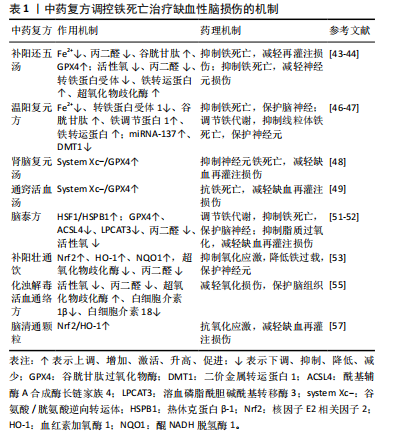

AKT/核因子E2相关因子2及SLC7A11/GPX4 通路,抑制铁死亡,保护神经。 β-石竹烯(β-caryophyllene,BCP):是从肉桂、丁香等植物中提出的一种双环倍半萜类化合物,具有抗炎、抗氧化、改善代谢等作用[60]。左天睿等[61]研究发现,β-石竹烯可减小大脑中动脉闭塞模型大鼠的脑梗死面积,改善神经元病理损伤,上调HSF1,p-HSF1,HSP70及凋亡相关蛋白表达,证实了β-石竹烯可通过激活HSF1/HSP70通道,减少活性氧生成及铁沉积,从而发挥抗氧化和抗铁死亡作用。 银杏内酯B (ginkgolide B,GB):是从银杏叶中提取的一种二萜类化合物,具有抗炎、抗氧化、保护神经等作用[62]。YANG等[63]研究发现,银杏内酯B通过阻断NCOA4-铁蛋白重链1相互作用,减少氧糖剥夺/复氧 HT22细胞内活性氧生成,降低Fe2+及丙二醛含量,从而抑制铁死亡,保护神经元。 (2)黄酮类 黄芩素(baicalein,BAI):是黄芩的主要活性成分之一,具有抗氧化、抗炎、抗肿瘤等作用[64]。LI等[65]用黄芩素干预经氧糖剥夺/复氧处理的HT22细胞,结果发现黄芩素可显著提高HT22细胞活力,减轻细胞损伤;同时,体内实验也证实,黄芩素可通过调控GPX4/ACSL4/ACSL3轴,缩小大脑中动脉闭塞模型小鼠的脑梗死面积,减少活性氧、丙二醛生成,降低脑铁浓度及铁死亡相关蛋白表达,抗铁死亡,保护神经元。 二氢杨梅素(dihydromyricetin,DHM):是从藤茶中提取的一种二氢黄酮类化合物,具有抗炎、抗菌、抗氧化、抗肿瘤等作用[66]。谢江波[67]研究发现,予大脑中动脉闭塞模型大鼠二氢杨梅素(100,200,250 mg/kg)灌胃,可改善大鼠的神经缺损症状,减小脑梗死体积,抑制脑组织鞘氨醇激酶1(SPHK1)、磷酸化雷帕霉素靶蛋白(p-mTOR)、ACSL4及PEBP1表达,促进GPX4表达,且与剂量呈正相关,证实了二氢杨梅素可通过抑制SPHK1/雷帕霉素靶蛋白通路,抑制铁死亡,减轻脑缺血再灌注损伤。 淫羊藿次苷Ⅱ(icari-sideⅡ,ICSⅡ):是淫羊藿的主要活性成分,具有抗炎、抗抑郁、保护神经等作用[68]。Gao等[69]体外原代星形胶质细胞氧糖剥夺/复氧实验发现,淫羊藿次苷Ⅱ6.25 μmol/L预处理,可与核因子E2相关因子2结合,并促进其转录,从而激活OXPHOS/核因子κB/铁死亡轴,抑制铁死亡,保护神经,此外,应用核因子E2相关因子2 siRNA则阻断了这种保护作用。 高良姜素:是从高良姜根茎中分离出来的一种黄酮类化合物,具有抗炎、抗氧化、抗纤维化等作用[70]。关雪[71]研究发现,予脑缺血再灌注损伤沙鼠高良姜素100 mg/kg灌胃14 d,可改善其学习和记忆能力,降低脑中脂质过氧化水平,下调Ptgs2表达,增加SLC7A11、GPX4表达,降低海马神经元Fe2+含量,证实了高良姜素可通过激活SLC7A11/GPX4通路减少脂质过氧化及铁超载,抑制神经元铁死亡。 (3)酚类:香芹酚(carvacrol,CA)是从牛至、百里香等植物中提取的一种酚类单萜,具有抗炎、抗氧化、抗菌等作用[72]。GUAN等[73]发现,香芹酚100 mg/kg可显著降低脑缺血再灌注沙鼠神经元损伤,提高其学习记忆能力,降低铁离子含量和脂质过氧化水平,表明香芹酚通过增加GPX4表达,抑制神经元铁死亡,从而抗缺血再灌注损伤。 (4)皂苷类 黄芪甲苷Ⅳ(astragaloside Ⅳ,AS-Ⅳ):是黄芪的主要活性成分,具有抗炎、抗氧化、改善循环、保护血脑屏障等作用[74]。WANG等[75]的体外SH-SY5Y细胞氧糖剥夺/复氧研究发现,应用黄芪甲苷Ⅳ40 μg/mL干预SH-SY5Y细胞,可激活 P62/Keap1/核因子E2相关因子2通路,上调P62、核因子E2相关因子2表达,提高细胞活力和谷胱甘肽水平,降低Fe2+、丙二醛、活性氧及脂质过氧化水平,从而抑制铁死亡,减轻再灌注损伤。 三七总皂苷(Panax notoginseng saponins,PNS):是从三七根茎部提取的一种活性成分,具有抗炎、抗肿瘤、调节免疫等药理作用[76]。WANG等[77]对SH-SY5Y细胞进行氧糖剥夺/复氧,建立脑缺血体外模型,经三七总皂苷干预后显示可减少细胞损伤和死亡;此外,体内大脑中动脉闭塞模型大鼠实验也证实,三七总皂苷可减少大鼠脑梗死面积,改善神经功能缺损情况,促进核因子E2相关因子2、血红素加氧酶1、谷胱甘肽及GPX4表达,降低脑组织丙二醛、Fe2+含量,其机制与激活核因子E2相关因子2/血红素加氧酶1通路,调节铁代谢,降低脂质过氧化水平,抑制铁死亡有关。 (5)生物碱类 川芎嗪(tetramethylpyrazine,TMP):是从川芎根部提取的一种生物碱,具有清除自由基、抗肿瘤、促进能量代谢等作用[78]。葛亮等[79]研究发现,予大脑中动脉闭塞模型大鼠川芎嗪50 mg/kg腹腔注射,连续6 d,可降低大鼠mNSS评分及梗死率,减少脑一氧化氮、丙二醛、炎症因子水平,提高钙离子腺苷三磷酸酶(Ca2+-ATP)酶及超氧化物歧化酶活性,从而抗氧化,清除活性氧,调节铁代谢,减轻缺血再灌注损伤,保护神经细胞。 延胡索乙素(dl-tetrahydropalmatine,dl-THP):是从延胡索中提取的一种生物碱,具有镇静、镇痛、抗肿瘤、抗氧化等作用[80]。甘椿椿等[81]研究发现,8 μg/mL延胡索乙素4可显著减少乳鼠海马神经元细胞氧糖剥夺/复氧模型的凋亡率,增加细胞内超氧化物歧化酶及GSH-PX活性,减少乳酸脱氢酶外漏及一氧化氮和丙二醛生成,发挥抗氧化作用。 (6)菲醌类:丹参酮ⅡA(AtanshinoneⅡA,TⅡA)是从丹参根茎部提取的一种活性成分,具有抗炎、抗氧化、降低神经毒性等作用[82]。许璐等[83]探讨丹参酮ⅡA对小鼠海马神经元HT22细胞铁死亡的影响,结果发现丹参酮ⅡA能促进HT22细胞内血红素加氧酶1表达,减少细胞内活性氧、脂质过氧化物及铁含量,从而抑制神经元铁死亡,发挥神经保护作用。 (7)多糖类:天麻多糖(G. elata polysaccharides,GEP)是天麻的主要活性成分,具有抗氧化、抗肿瘤、调节免疫等作用[84]。ZHANG 等[85]发现,500 μg/mL天麻多糖预处理氧糖剥夺/复氧HT22细胞,可激活核因子E2相关因子2/血红素加氧酶1通路,降低细胞内活性氧、丙二醛及Fe2+含量,上调GPX4表达,从而抑制铁死亡、保护神经元。 (8)苯酞类:藁本内酯(Ligustilide,LIG)是当归和川芎的主要活性成分,具有抗氧化、改善微循环、保护血脑屏障等作用[86]。SHI等[87]研究发现,藁本内酯40 μmol/L可提高氧糖剥夺/复氧诱导的PC12细胞活力,降低脂质过氧化水平,下调转铁蛋白受体1、核受体共激活因子4 (NCOA4)、微管相关蛋白1轻链3(LC3)表达,从而阻断铁超载、抑制铁死亡。 由上可得,中药单体有效成分萜类,黄酮,皂苷,生物碱,苯酞类等均通过调节脑缺血中神经元铁死亡,减少神经细胞损伤或死亡,发挥脑保护作用,具体机制见表2。"

| [1] 中华医学会神经病学分会,中华医学会神经病学分会脑血管病学组.中国急性缺血性脑卒中诊治指南2018[J].中华神经科杂志, 2018,51(9):666-682. [2] 樊冰,王阳,宁绍爽.疏血通对急性脑梗死患者认知行为学及神经影像学的影响[J].中华中医药学刊,2022,40(11):100-103. [3] BULLI I, DETTORI I, COPPI E, et al. Role of Carbonic Anhydrase in Cerebral Ischemia and Carbonic Anhydrase Inhibitors as Putative Protective Agents. Int J Mol Sci. 2021;22(9):5029. [4] KIM E, CHO S. CNS and peripheral immunity in cerebral ischemia: Partition and interaction. Exp Neurol. 2021;335(10):1135-1138. [5] 王记委,李雁冰,李娜,等.针刺治疗通过抑制细胞凋亡改善缺血性脑卒中疗效及其机制[J].中国老年学杂志,2024,44(7):1773-1777. [6] SUZUKI K, MATSUMARU Y, TAKEUCHI M, et al. Effectof Mechanical Thrombectomy Without vs With Intravenous Throm-bolysis on Functional Outcome Among Patients With AcuteIschemic Stroke:The SKIP Randomized Clinical Trial. JAMA. 2021;325(3):244-253. [7] 石晓花,莽靖,徐忠信.脑缺血再灌注损伤细胞死亡模式的研究进展[J].吉林大学学报(医学版),2022,48(6):1635-1643. [8] 李文静,李强,孙会艳.铁死亡参与缺血性脑卒中后神经损伤发病机制及其治疗进展[J].河北医科大学学报,2023,44(12):1478-1485. [9] 龚卓之,曹增,姚梦茜,等.从铁死亡探讨溃疡性结肠炎不同时期的发病机制及相关天然药物筛选[J].中草药,2023,54(7):2187-2196. [10] SHIBATA Y, YASUI H, HIGASHIKAWA K, et al. Transferrin-based radiolabeled probe predicts the sensitivity of human renal cancer cell lines to ferroptosis inducer erastin. Biochem Biophys Rep. 2021;26: 100957. [11] TANG D, CHEN X, KANG R, et al. Ferroptosis: molecular mechanisms and health implications. Cell Res. 2021;31(2):107-125. [12] YAN HF, TUO QZ, YIN QZ, et al. The pathological role of ferroptosis in ischemia/reperfusion-related injury. Zool Res. 2020;41(3):220-230. [13] HAJIEVA P, ABROSIMOV R, KUNATH S, et al. Antioxidant and prooxidant modulation of lipid peroxidation by integral membrane proteins. Free Radic Res. 2023;57(2):105-114. [14] XU YY, WAN WP, ZHAO S, et al. L-type Calcium Channels are Involved in Iron-induced Neurotoxicity in Primary Cultured Ventral Mesencephalon Neurons of Rats. Neurosci Bull. 2020;36(2):165-173. [15] 王梅芳,李德冠.铁死亡及其在心脑血管疾病中的研究进展[J].生命科学,2019,31(9):886-893. [16] LI T, ZHAO L, LI Y, et al. PPM1K mediates metabolic disorder of branched-chain amino acid and regulates cerebral ischemia-reperfusion injury by activating ferroptosis in neurons. Cell Death Dis. 2023;14(9):634. [17] BERSUKER K, HENDRICKS JM, LI Z, et al.The CoQ oxidoreductase FSP1 acts parallel to GPX4 to inhibit ferroptosis. Nature. 2019;575(7784): 688-692. [18] LIANG C, ZHANG X, YANG M, et al.Recent Progress in Ferroptosis Inducers for Cancer Therapy. Adv Mater. 2019;31(51):e1904197. [19] LEI P, BAI T, SUN Y. Mechanisms of Ferroptosis and Relations With Regulated Cell Death: A Review. Front Physiol. 2019;10:139. [20] 张一楠,任彩佩,吴亚俐,等.白藜芦醇通过调节铁死亡通路抑制小鼠溃疡性结肠炎相关性结肠癌实验研究[J].陕西医学杂志,2023, 52(6):671-675+682. [21] JIANG X, STOCKWELL BR, CONRAD M. Ferroptosis: mechanisms, biology and role in disease. Nat Rev Mol Cell Biol. 2021;22(4):266-282. [22] FUJII J, HOMMA T, KOBAYASHI S. Ferroptosis caused by cysteine insufficiency and oxidative insult. Free Radic Res. 2020;54(11-12): 969-980. [23] LI J, LU K, SUN F, et al. Panaxydol attenuates ferroptosis against LPS-induced acute lung injury in mice by Keap1-Nrf2/HO-1 pathway. J Transl Med. 2021;19(1):96. [24] WU CT, DENG JS, HUANG WC, et al. Salvianolic Acid C against Acetaminophen-Induced Acute Liver Injury by Attenuating Inflammation, Oxidative Stress, and Apoptosis through Inhibition of the Keap1/Nrf2/HO-1 Signaling. Oxid Med Cell Longev. 2019;2019:9056845. [25] CHEN M, SHI Z, SUN Y, et al. Prospects for Anti-Tumor Mechanism and Potential Clinical Application Based on Glutathione Peroxidase 4 Mediated Ferroptosis. Int J Mol Sci. 2023;24(2):1607. [26] 沈惟钰,吴艳,卞涛.铁死亡抑制蛋白1在铁死亡相关疾病中的研究进展[J].安徽医药,2023,27(3):425-428. [27] KRAFT VAN, BEZJIAN CT, PFEIFFER S, et al. GTP cyclohydrolase 1/tetrahydrobiopterin counteract ferroptosis through lipid remodeling. ACS Cent Sci. 2020;6(1):41-53. [28] 李文静,李强,孙会艳.铁死亡参与缺血性脑卒中后神经损伤发病机制及其治疗进展[J].河北医科大学学报,2023,44(12):1478-1485. [29] LEE H, ZANDKARIMI F, ZHANG Y, et al. Energy-stress-mediated AMPK activation inhibits ferroptosis. Nat Cell Biol. 2020;22(2):225-234. [30] CHEN Y, FANG ZM, YI X, et al. The interaction between ferroptosis and inflammatory signaling pathways. Cell Death Dis. 2023;14(3):205. [31] MÜLLER S, KUFNER A, DELL’ORCO A, et al. Evolution of Blood-Brain Barrier Permeability in Subacute Ischemic Stroke and Associations With Serum Biomarkers and Functional Outcome. Front Neurol. 2021; 12:730923. [32] KAJARABILLE N, LATUNDE-DADA GO. Programmed Cell-Death by Ferroptosis: Antioxidants as Mitigators. Int J Mol Sci. 2019;20(19):4968. [33] RYAN F, ZARRUK JG, LÖßLEIN L, et al. Ceruloplasmin Plays a Neuroprotective Role in Cerebral Ischemia. Front Neurosci. 2019;12: 988. [34] ZHANG B, DI X, SONG Y, et al. Effect of Ultramicro Superparamagnetic Iron Oxide Nanoparticles on Cerebral Infarction in Mice. J Nanosci Nanotechnol. 2020;20(12):7305-7310. [35] KRISHNAMOORTHY S, SINGH G, JOSE KJ, et al. Biomarkers in the Prediction of Hemorrhagic Transformation in Acute Stroke: A Systematic Review and Meta-Analysis. Cerebrovasc Dis.2022;51(2):235-247. [36] ZHANG Y, LU X, TAI B, et al. Ferroptosis and Its Multifaceted Roles in Cerebral Stroke. Front Cell Neurosci. 2021;15:615372. [37] 赵文举,付海鑫,应春苗,等.中药调控铁死亡抑制脑缺血再灌注损伤的研究进展[J].中草药,2024,55(8):2812-2819. [38] BILLINGHAM LK, STOOLMAN JS, VASAN K, et al. Mitochondrial electron transport chain is necessary for NLRP3 inflammasome activation. Nat Immunol. 2022;23(5):692-704. [39] JELINEK M, JURAJDA M, DURIS K. Oxidative Stress in the Brain: Basic Concepts and Treatment Strategies in Stroke. Antioxidants (Basel). 2021;10(12):1886. [40] RODRIGO R, FERNÁNDEZ-GAJARDO R, GUTIÉRREZ R, et al. Oxidative stress and pathophysiology of ischemic stroke: novel therapeutic opportunities. CNS Neurol Disord Drug Targets. 2023;12(5):698-714. [41] Lauridsen C. From oxidative stress to inflammation:redox balance and immune system. Poult Sci. 2019;98(10):4240-4246. [42] 辛紫媛,刘真一,高萍,等.补阳还五汤通过激活大鼠海马区沉默信息调节因子1减轻脑缺血/再灌注损伤后炎症反应的机制[J].中国药理学通报,2023,39(9):1787-1793. [43] 蔡国英,刘均广,叶佳蓓,等.补阳还五汤增强GPX4表达抑制铁死亡减轻脑缺血再灌注损伤[J].承德医学院学报,2024,41(1):10-14. [44] 梁祺,吴海辉,王珊珊,等.补阳还五汤调节铁代谢蛋白改善脑缺血神经元损伤的研究[J].湖南中医药大学学报,2023,43(1):40-46. [45] 胡跃强,唐农,何乾超,等.温阳复元方治疗缺血性脑卒中恢复期患者的临床疗效及其机制[J].中国老年学杂志,2018,38(19):4627-4629. [46] 向军军,李丽琴,李建铮,等.基于铁死亡探讨温阳复元方对脑缺血再灌注损伤大鼠神经损伤的保护机制[J].中药新药与临床药理, 2023,34(12):1649-1657. [47] 邓秋媚,吴林,袁莉,等.温阳复元方通过调控miRNA-137/线粒体铁死亡通路保护大鼠脑缺血再灌注损伤机制研究[J].辽宁中医药大学学报,2024,26(2):31-36. [48] 杨莹婕.基于System Xc-/GPX4通路调控铁死亡探讨肾脑复元汤对脑缺血再灌注模型大鼠的作用机制[D].长沙:湖南中医药大学, 2024. [49] 娄原.通窍活血汤调控System Xc--GPX4通路对抗铁死亡治疗CIRI的作用机制研究[D].济南:山东中医药大学,2024. [50] 贺旭,宋祯彦,葛金文,等.脑泰方治疗脑卒中的研究进展[J].中国组织化学与细胞化学杂志,2021,30(4):387-391+400. [51] 饶政清,梅志刚,葛金文,等.脑泰方调控细胞铁转运抑制铁死亡保护脑卒中缺血损伤的机制研究[J].中草药,2021,52(21):6552-6560. [52] 贺超,廖君,兰斌,等.脑泰方对脑梗死后铁死亡-脂质代谢通路蛋白表达的影响[J].中华中医药杂志,2020,35(11):5491-5494. [53] 王亚南.基于Nrf2信号通路介导的抗氧化应激损伤探索补阳壮通饮对MCAO/R模型大鼠的神经保护作用[D].南宁:广西中医药大学,2024. [54] 韩宇帆,霍瑞卿,李芳钊,等.化浊解毒活血通络方通过调控核因子E2相关因子2/Kelch 样环氧氯丙烷相关蛋白-1通路发挥对脑缺血再灌注损伤大鼠脑组织抗氧化作用的机制研究[J].河北中医,2022,44(11):1861-1869. [55] 曹晓慧,赵敏菡,霍瑞卿,等.化浊解毒活血通络方对脑缺血再灌注损伤大鼠氧化损伤和炎症因子的影响[J].中华中医药杂志,2024, 39(4):1979-1984. [56] 周海哲,严亚锋,辛宝,等.脑清通颗粒对肝热痰瘀证高血压模型大鼠血清hs-CRP及血管形态的影响[J].世界中西医结合杂志, 2022,17(6):1121-1125. [57] 严亚锋,刘伟,王斌,等.基于Nrf2/HO-1信号通路探讨脑清通颗粒对脑缺血再灌注大鼠的保护作用及机制[J].中药药理与临床, 2024,40(3):23-28. [58] XIAO S, WANG C, YANG Q, et al. Rea regulates microglial polarization and attenuates neuronal apoptosis via inhibition of the NF-κB and MAPK signalings for spinal cord injury repair. J Cell Mol Med. 2021; 25(3):1371-1382. [59] FU C, WU Y, LIU S, et al. Rehmannioside A improves cognitive impairment and alleviates ferroptosis via activating PI3K/AKT/Nrf2 and SLC7A11/GPX4 signaling pathway after ischemia. J Ethnopharmacol. 2022;289:115021. [60] 何睿樵.基于网络药理学探讨β-石竹烯对心肌缺血再灌注损伤的作用机制[D].广州:南方医科大学,2024. [61] 左天睿,胡晴雯,刘京东,等.β-石竹烯通过激活HSF1/HSP70通路减轻大鼠脑缺血再灌注损伤[J].中国新药杂志,2023,32(5):513-521. [62] 刘佳,叶岩荣,沈赟,等.银杏内酯B通过调控脑内T细胞特性及与胶质细胞间相互作用促进缺血性脑卒中小鼠的神经功能恢复[J].实验动物与比较医学,2024,44(2):139-148. [63] YANG Y, WU Q, SHAN X, et al. Ginkgolide B attenuates cerebral ischemia-reperfusion injury via inhibition of ferroptosis through disrupting NCOA4-FTH1 interaction. J Ethnopharmacol. 2024;318(Pt B): 116982. [64] 高建亭,路晨月,师鑫潮,等.黄芩素固体分散体的制备、表征及体内外释药研究[J].中国畜牧兽医,2024,51(5):2169-2177. [65] LI M, MENG Z, YU S, et al. Baicalein ameliorates cerebral ischemia-reperfusion injury by inhibiting ferroptosis via regulating GPX4/ACSL4/ACSL3 axis. Chem Biol Interact. 2022;366:110137. [66] 龙俊鹏,孙洋,刘莎莎,等.二氢杨梅素神经保护作用研究进展[J].中国药理学通报,2023,39(8):1422-1425. [67] 谢江波.二氢杨梅素对脑缺血再灌注损伤大鼠的保护作用及其机制研究[D].济南:山东大学,2024. [68] 熊庭旺,张珏,孙成新,等.基于GABA能神经系统探究淫羊藿次苷Ⅱ的抗抑郁作用及机制[J].中国药房,2024,35(2):145-149. [69] GAO J, MA C, XIA D, et al. Icariside II preconditioning evokes robust neuroprotection against ischaemic stroke, by targeting Nrf2 and the OXPHOS/NF-κB/ferroptosis pathway. Br J Pharmacol. 2023;180(3):308-329. [70] THAPA R, AFZAL O, GOYAL A, et al .Galangin as an inflammatory response modulator: An updated overview and therapeutic potential. Chem Biol Interact. 2023;378:110482. [71] 关雪.高良姜素对脑缺血再灌注损伤沙鼠海马神经元的保护作用及机制研究[D].沈阳:辽宁中医药大学,2023. [72] 王蕊,杨昕,吴腾飞,等.香芹酚对糖尿病肾病大鼠肾功能及肾组织Notch2/ hes1信号通路的影响[J].解剖科学进展,2023,29(6): 589-591+596. [73] GUAN X, LI X, YANG X, et al. The neuroprotective effects of carvacrol on ischemia/reperfusion-induced hippocampal neuronal impairment by ferroptosis mitigation. Life Sci. 2019;235:116795. [74] 秦合伟,孙孟艳,王梦楠,等.黄芪甲苷控Nrf2/HO-1/GPX4通路抑制铁死亡改善ApoE-/-小鼠动脉粥样硬化的机制研究[J].中国中药杂志,2024,49(13):3619-3626. [75] WANG L, LIU C, WANG L, et al. Astragaloside IV mitigates cerebral ischaemia-reperfusion injury via inhibition of P62/Keap1/Nrf2 pathway-mediated ferroptosis. Eur J Pharmacol. 2023;944:175516. [76] 李靖,张旭,张玉尧,等.三七总皂苷发酵工艺优化及发酵前后免疫调节作用研究[J].中国医院药学杂志,2024,44(7):764-771. [77] WANG LL, KANG ML, LIU CW, et al. Panax notoginseng Saponins Activate Nuclear Factor Erythroid 2-Related Factor 2 to Inhibit Ferroptosis and Attenuate Inflammatory Injury in Cerebral Ischemia-Reperfusion. Am J Chin Med. 2024;52(3):821-839. [78] 杨春昆,潘清泉,吉奎,等.川芎嗪对心血管的保护机制综述[J].中国中药杂志,2023,48(6):1446-1454. [79] 葛亮,曹慧玲,张洁,等.川芎嗪对大鼠脑缺血再灌注损伤后氧化应激、Ca2+-ATP酶活性及炎症因子的影响[J].国际检验医学杂志, 2021,42(5):517-520. [80] 陈斯.延胡索化学成分和药理作用研究进展[J].中医药信息,2021, 38(7):78-82. [81] 甘椿椿,金湛,汪琴猛,等.延胡索乙素对乳鼠海马神经元缺氧缺糖损伤保护作用的研究[J].中国民族民间医药,2019,28(19):14-18. [82] 母伟林,邵欣欣,弭志成,等.丹参及其药对的药理研究进展[J].中华中医药学刊:1-8. [83] 许璐,汤其强.丹参酮ⅡA抑制HT22海马神经元发生铁死亡的机制研究[J].安徽医科大学学报,2019,54(6):833-839. [84] 李俊杰,黄艳,亢凯杰,等.不同pH值溶剂对昭通乌天麻多糖提取率及抗氧化能力研究[J].农产品加工,2024(5):18-21+25. [85] ZHANG Y, YE P, ZHU H, et al. Neutral polysaccharide from Gastrodia elata alleviates cerebral ischemia-reperfusion injury by inhibiting ferroptosis-mediated neuroinflammation via the NRF2/HO-1 signaling pathway. CNS Neurosci Ther. 2024;30(3):e14456. [86] 李喜香,杨萍,张亚会,等.藁本内酯治疗神经系统疾病作用机制的研究进展[J].中国中药杂志,2024,49(9):2290-2298. [87] SHI L, JIANG CC, LU JJ, et al. Molecular mechanism of ligustilide attenuating OGD/R injury in PC12 cells by inhibiting ferroptosis. Zhongguo Zhong Yao Za Zhi. 2023;48(11):3046-3054. |
| [1] | Yin Lu, Jiang Chuanfeng, Chen Junjie, Yi Ming, Wang Zihe, Shi Houyin, Wang Guoyou, Shen Huarui. Effect of Complanatoside A on the apoptosis of articular chondrocytes [J]. Chinese Journal of Tissue Engineering Research, 2025, 29(8): 1541-1547. |
| [2] | Zhou Panpan, Cui Yinglin, Zhang Wentao, Wang Shurui, Chen Jiahui, Yang Tong . Role of cellular autophagy in cerebral ischemic injury and the regulatory mechanism of traditional Chinese medicine [J]. Chinese Journal of Tissue Engineering Research, 2025, 29(8): 1650-1658. |
| [3] | Yu Ting, Lyu Dongmei, Deng Hao, Sun Tao, Cheng Qian. Icariin pretreatment enhances effect of human periodontal stem cells on M1-type macrophages [J]. Chinese Journal of Tissue Engineering Research, 2025, 29(7): 1328-1335. |
| [4] | Aikepaer · Aierken, Chen Xiaotao, Wufanbieke · Baheti. Osteogenesis-induced exosomes derived from human periodontal ligament stem cells promote osteogenic differentiation of human periodontal ligament stem cells in an inflammatory microenvironment [J]. Chinese Journal of Tissue Engineering Research, 2025, 29(7): 1388-1394. |
| [5] | Zhang Haojun, Li Hongyi, Zhang Hui, Chen Haoran, Zhang Lizhong, Geng Jie, Hou Chuandong, Yu Qi, He Peifeng, Jia Jinpeng, Lu Xuechun. Identification and drug sensitivity analysis of key molecular markers in mesenchymal cell-derived osteosarcoma [J]. Chinese Journal of Tissue Engineering Research, 2025, 29(7): 1448-1456. |
| [6] | Sun Yuting, Wu Jiayuan, Zhang Jian. Physical factors and action mechanisms affecting osteogenic/odontogenic differentiation of dental pulp stem cells [J]. Chinese Journal of Tissue Engineering Research, 2025, 29(7): 1531-1540. |
| [7] | Zhao Ruihua, Chen Sixian, Guo Yang, Shi Lei, Wu Chengjie, Wu Mao, Yang Guanglu, Zhang Haoheng, Ma Yong. Wen-Shen-Tong-Du Decoction promoting spinal cord injury repair in mice [J]. Chinese Journal of Tissue Engineering Research, 2025, 29(6): 1118-1126. |
| [8] | Zheng Lin, Jin Wenjun, Luo Shanshan, Huang Rui, Wang Jie, Cheng Yuting, An Zheqing, Xiong Yue, Gong Zipeng, Liao Jian. Eucommia ulmoides promotes alveolar bone formation in ovariectomized rats [J]. Chinese Journal of Tissue Engineering Research, 2025, 29(6): 1159-1167. |
| [9] | Zhang Debao, Wang Peng, Li Kun, Zhang Shaojie, Li Zhijun, Li Shuwen, Wu Yimin. Epidural fibrous scar formation in rabbits following autologous ligamentum flavum intervention [J]. Chinese Journal of Tissue Engineering Research, 2025, 29(6): 1168-1175. |
| [10] | Ji Huihui, Jiang Xu, Zhang Zhimin, Xing Yunhong, Wang Liangliang, Li Na, Song Yuting, Luo Xuguang, Cui Huilin, Cao Ximei. SR9009 combined with indolepropionic acid alleviates inflammation in C2C12 myoblasts through the nuclear factor-kappa B signaling pathway [J]. Chinese Journal of Tissue Engineering Research, 2025, 29(6): 1220-1229. |
| [11] | He Bo, Chen Wen, Ma Suilu, He Zhijun, Song Yuan, Li Jinpeng, Liu Tao, Wei Xiaotao, Wang Weiwei, Xie Jing . Pathogenesis and treatment progress of flap ischemia-reperfusion injury [J]. Chinese Journal of Tissue Engineering Research, 2025, 29(6): 1230-1238. |
| [12] | Zhang Wenhua, Li Xun, Zhang Weichao, Li Xinying, Ma Guoao, Wang Xiaoqiang . Promoting myogenesis based on the SphK1/S1P/S1PR2 signaling pathway: a new perspective on improving skeletal muscle health through exercise [J]. Chinese Journal of Tissue Engineering Research, 2025, 29(6): 1265-1275. |
| [13] | Liu Lingyun, He Guixin, Qin Weibin, Song Hui, Zhang Liwen, Tang Weizhi, Yang Feifei, Zhu Ziyi, Ou Yangbin . Improvement of myocardial injury by traditional Chinese medicine: mitochondrial calcium homeostasis mediates macrophage autophagy and pyroptosis pathway [J]. Chinese Journal of Tissue Engineering Research, 2025, 29(6): 1276-1284. |
| [14] | Xu Tianjie, Fan Jiaxin, Guo Xiaoling, Jia Xiang, Zhao Xingwang, Liu kainan, Wang Qian. Metformin exerts a protective effect on articular cartilage in osteoarthritis rats by inhibiting the PI3K/AKT/mTOR pathway [J]. Chinese Journal of Tissue Engineering Research, 2025, 29(5): 1003-1012. |
| [15] | Lan Shuangli, Xiang Feifan, Deng Guanghui, Xiao Yukun, Yang Yunkang, Liang Jie. Naringin inhibits iron deposition and cell apoptosis in bone tissue of osteoporotic rats [J]. Chinese Journal of Tissue Engineering Research, 2025, 29(5): 888-898. |
| Viewed | ||||||
|
Full text |
|
|||||
|
Abstract |
|
|||||